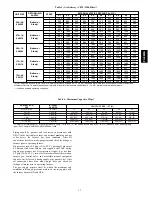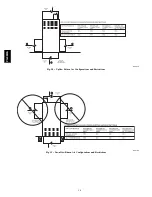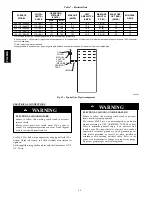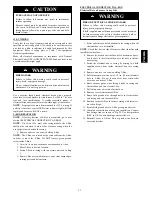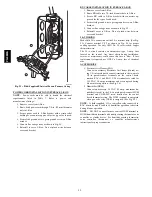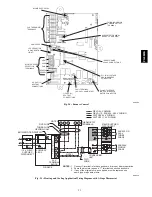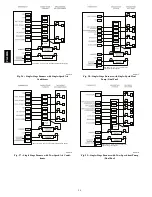
10
Ifan = combined input of all fan--assisted appliances in Btuh/hr
ACH = air changes per hour (ACH shall not exceed 0.60.)
The following requirements apply to the Standard Method and to
the Known Air Infiltration Rate Method.
1. Adjoining rooms can be considered part of a space if:
a. There are no closeable doors between rooms.
b. Combining spaces on same floor level. Each opening
shall have free area of at least 1 in.
2
/1,000 Btuh (2,000
mm
2
/kW) of the total input rating of all gas appliances
in the space, but not less than 100 in.
2
(0.06 m
2
). One
opening shall commence within 12” (300 mm) of the ceil-
ing and the second opening shall commence within 12”
(300 mm) of the floor. The minimum dimension of air
openings shall be at least 3 in. (80 mm). (See Fig. 8.)
c. Combining space on different floor levels. The volumes
of spaces on different floor levels shall be considered as
communicating spaces if connected by one or more per-
manent openings in doors or floors having free area of
at least 2 in.
2
/1,000 Btuh (4,400 mm
2
/kW) of total input
rating of all gas appliances.
2. An attic or crawlspace may be considered a space that
freely communicates with the outdoors provided there are
adequate permanent ventilation openings directly to out-
doors having free area of at least 1--in.
2
/4,000 Btuh of total
input rating for all gas appliances in the space.
3. In spaces that use the Indoor
Combustion Air Method
,
infiltration should be adequate to provide air for combus-
tion, permanent ventilation and dilution of flue gases.
However, in buildings with unusually tight construction,
additional air MUST be provided using the methods de-
scribed in the
Outdoor Combustion Air
Method section.
Unusually tight construction is defined as construction with:
a. Walls and ceilings exposed to the outdoors have a con-
tinuous, sealed vapor barrier. Openings are gasketed or
sealed and
b. Doors and openable windows are weatherstripped and
c. Other openings are caulked or sealed. These include
joints around window and door frames, between sole
plates and floors, between wall--ceiling joints, between
wall panels, at penetrations for plumbing, electrical and
gas lines, etc.
Combination of Indoor and Outdoor Air
1. Indoor openings shall comply with the Indoor Combus-
tion Air Method below and,
2. Outdoor openings shall be located as required in the
Out-
door Combustion
Air Method mentioned previously and,
3. Outdoor openings shall be sized as follows:
a. Calculate the Ratio of all Indoor Space volume divided
by required volume for
Indoor Combustion Air
Meth-
od below.
b. Outdoor opening size reduction Factor is 1 minus the Ra-
tio in a. above.
c. Minimum size of Outdoor openings shall be the size re-
quired in Outdoor Combustion Air Method above multi-
plied by reduction Factor in b. above. The minimum di-
mension of air openings shall be not less than 3 in. (80
mm).
INSTALLATION
UPFLOW INSTALLATION
Bottom Return Air Inlet
These furnaces are shipped with bottom closure panel installed in
bottom return--air opening. Remove and discard this panel when
bottom return air is used. To remove bottom closure panel,
perform the following:
1. Tilt or raise furnace and remove two screws holding bot-
tom filler panel. (See Fig. 9.)
Bottom
Closure Panel
Bottom Filler Panel
A10273
Fig. 9 -- Removing Bottom Closure Panel
2. Rotate bottom filler panel downward to release holding
tabs.
3. Remove bottom closure panel.
4. Reinstall bottom filler panel and screws.
Side Return Air Inlet
These furnaces are shipped with bottom closure panel installed in
bottom return--air opening. This panel MUST be in place when
only side return air is used.
NOTE
: Side return--air openings can be used in UPFLOW and
most HORIZONTAL configurations. Do not use side return--air
openings in DOWNFLOW configuration.
Leveling Legs (If Desired)
In upflow position with side return inlet(s), leveling legs may be
used. (See Fig. 10.) Install field--supplied, 5/16 x 1--1/2 in. (8 x
38 mm) (max) corrosion--resistant machine bolts, washers and
nuts.
NOTE
: Bottom closure must be used when leveling legs are
used. It may be necessary to remove and reinstall bottom closure
panel to install leveling legs. To remove bottom closure panel, see
Item 1. in Bottom Return Air Inlet section.
To install leveling legs:
1. Position furnace on its back. Locate and drill a hole in
each bottom corner of furnace. (See Fig. 10.)
2. For each leg, install nut on bolt and then install bolt and
nut in hole. (Install flat washer if desired.)
3. Install another nut on other side of furnace base. (Install
flat washer if desired.)
PG
8M
EA
Summary of Contents for PG8JEA
Page 4: ...4 A10269 Fig 2 Clearances to Combustibles PG8MEA ...
Page 28: ...28 A10133 Fig 33 Chimney Inspection Chart PG8MEA ...
Page 38: ...38 Table 13 Orifice Size and Manifold Pressure In W C for Gas Input Rate A10180 PG8MEA ...
Page 39: ...39 Table 13 Orifice Size and Manifold Pressure In W C for Gas Input Rate CONT A10180A PG8MEA ...
Page 40: ...40 Table 14 Orifice Size And Manifold Pressure In W C For Gas Input Rate A10181 PG8MEA ...
Page 41: ...41 Table 14 Orifice Size And Manifold Pressure In W C For Gas Input Rate CONT A10181A PG8MEA ...

















